大学英语六级翻译策略之汉语主动句译成英语被动句
- 格式:pdf
- 大小:264.54 KB
- 文档页数:4
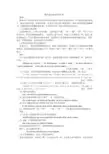
简析英汉被动句的互译摘要:被动句—当主语不是行为动作的发出者而是行为动作的承受者时,句子就含有被动意味了。
被动句表示的是一种被动语态,在英语中和汉语中都很常见。
因此,在两种语言的翻译中,把握好被动句的翻译很重要!本文简单介绍了英汉互译的几种情况!1汉语被动句的英译汉语的被动句,大体可分为两类:一是用助词“被”,“受”,“遭”,“给”,“叫”,“让”等为标记,表示较强的被动意义。
二是形式上是主动式,但意义上是被动式,即:意念上的汉语被动句。
主语是谓语动词的承受者。
这两类句子在译成英语时都要用被动语态。
当然,还有一些特殊情况,及汉语某些习语的译法。
1.1带有被动标记的汉语被动句这类句子,一般表示较强的被动意义,着重于被动的动作。
此类句子可以按照英语的惯常用法,相应地译成英语的被动句子。
用助词“被”,“受”,“遭”,“给”,“叫”,“让”等为标记。
例如:(1)“没有调查就没有发言权”这句话,虽然曾经被人讥为“狭隘经验论”的,我却至今不悔;……Although my assertion , “ No investigation , no right to speak ”, has been ridiculed as “ narrow empiricism ” , to this day I do not regret having made it ;……《毛泽东选集》三卷, 749页(2)在这里,可以听到最荒唐的新闻,如某处的大蜘蛛怎么成了精,受了雷击。
In the teahouses one could hear the most absurd stories , such as how in a certain place a huge spider had turned into a demon and was then struck by lighting .老舍《茶馆》(3)没有一个人把小草叫做“大力士”,但它的力量之大,的确是世界无比。
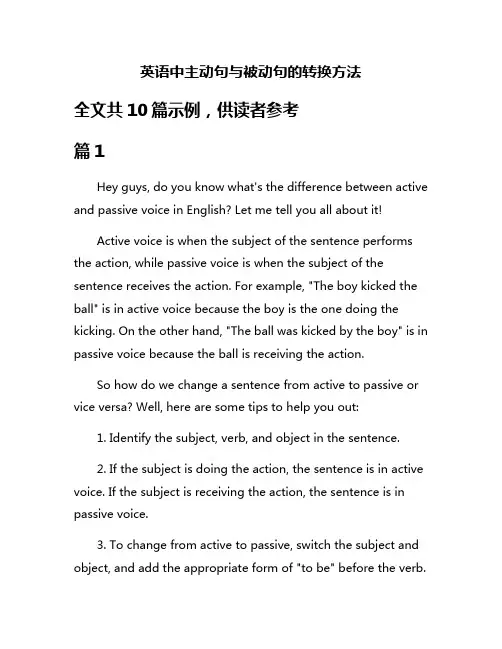
英语中主动句与被动句的转换方法全文共10篇示例,供读者参考篇1Hey guys, do you know what's the difference between active and passive voice in English? Let me tell you all about it!Active voice is when the subject of the sentence performs the action, while passive voice is when the subject of the sentence receives the action. For example, "The boy kicked the ball" is in active voice because the boy is the one doing the kicking. On the other hand, "The ball was kicked by the boy" is in passive voice because the ball is receiving the action.So how do we change a sentence from active to passive or vice versa? Well, here are some tips to help you out:1. Identify the subject, verb, and object in the sentence.2. If the subject is doing the action, the sentence is in active voice. If the subject is receiving the action, the sentence is in passive voice.3. To change from active to passive, switch the subject and object, and add the appropriate form of "to be" before the verb.For example, "The teacher (subject) teaches (verb) the students (object)" becomes "The students (subject) are taught (verb) by the teacher."4. To change from passive to active, identify the subject performing the action and make it the new subject, then add the verb in the appropriate tense. For example, "The cake (subject) was baked (verb) by Mary (object)" becomes "Mary (subject) baked (verb) the cake."Remember, practice makes perfect! Keep practicing converting sentences from active to passive and passive to active, and soon you'll be a pro at using both forms in English. Have fun learning and don't forget to always use your English skills to impress others!篇2Hello everyone! Today, I'm going to talk about how to change active voice to passive voice in English. It's super easy once you get the hang of it!First things first, what's the difference between active and passive voice? In active voice, the subject of the sentence is doing the action. For example, "The dog chased the cat." The dog is the subject and it's doing the chasing. In passive voice, thesubject is being acted upon. For example, "The cat was chased by the dog." The cat is the subject and it's being chased by the dog.Now, let's talk about how to change from active to passive. Here are the steps:1. Identify the subject, verb, and object in the active sentence.2. Move the object of the active sentence to the beginning of the sentence.3. Add the helping verb "to be" in the correct tense.4. Change the main verb to its past participle form.5. Add the preposition "by" followed by the subject of the active sentence (optional).For example, let's change the active sentence "The teacher is explaining the lesson" to passive voice. First, identify the subject (The teacher), verb (is explaining), and object (the lesson). Then, move the object to the beginning: "The lesson is being explained." Add the helping verb "is" and change "explain" to "explained."And that's it! Remember to practice a lot and you'll get the hang of it in no time. Have fun learning English!篇3Hey guys, today I'm going to tell you all about active and passive voice in English. It's really important to know the difference between these two so you can sound great when you talk or write!So, first things first, what's the difference between active and passive voice? Well, in active voice, the subject of the sentence is doing the action. For example, "Sarah ate the cake." Sarah is the subject and she's doing the action of eating the cake. It's all about who is doing what.On the other hand, in passive voice, the subject of the sentence is not doing the action. The action is being done to the subject. For example, "The cake was eaten by Sarah." The cake is the subject here and it's not doing anything - it's just being eaten by Sarah.Now, how do we change a sentence from active to passive or vice versa? It's actually not that hard! To change from active to passive, you just need to switch the positions of the subject and the object and add a form of the verb "to be" plus the past participle of the main verb. For example, "The cat chased the mouse" becomes "The mouse was chased by the cat."And to change from passive to active, you do the opposite - switch the positions of the subject and the object and use the correct form of the verb. For example, "The cake was baked by Mary" becomes "Mary baked the cake."So there you have it, guys! Active and passive voice may seem a little tricky at first, but with a little practice, you'll be a pro in no time. Keep practicing and you'll be speaking and writing like a native English speaker in no time!篇4Hey guys, do you know what active and passive voice are in English? Let me explain it to you in a simple way!Active voice is when the subject of the sentence is doing the action. For example, "The cat is eating the fish." The cat is the subject and it is doing the action of eating.Passive voice is when the subject of the sentence is not doing the action, but receiving it instead. For example, "The fish is being eaten by the cat." The fish is the subject, but it is not doing the action of eating, it is being eaten by the cat.Now, let's talk about how to change a sentence from active voice to passive voice and vice versa.To change a sentence from active to passive, follow these steps:1. Identify the subject, verb, and object in the active sentence.2. Move the object of the active sentence to the beginning of the passive sentence.3. Add the correct form of the verb "to be" (am, is, are, was, were) followed by the past participle of the main verb.4. Add the subject of the active sentence at the end of the passive sentence (optional).5. Make sure to change the verb form if necessary.For example:Active: The boy is eating an apple.Passive: An apple is being eaten by the boy.To change a sentence from passive to active, follow these steps:1. Identify the subject, verb, and object in the passive sentence.2. Move the subject of the passive sentence to the beginning of the active sentence.3. Remove the form of the verb "to be" and the past participle of the main verb.4. Change the main verb to its appropriate form.5. Make sure to change the verb form if necessary.For example:Passive: The cake was made by my mom.Active: My mom made the cake.I hope you guys now understand how to switch between active and passive voice in English. Keep practicing and you'll get the hang of it!篇5Hey guys! Today I'm going to talk about how to change active voice into passive voice and vice versa in English. It might sound tricky, but I'll try to make it super easy for you to understand.First, let's talk about what active and passive voice are. In active voice, the subject is doing the action. For example, "I loveice cream." In passive voice, the subject is receiving the action. For example, "Ice cream is loved by me."To change from active to passive voice, follow these steps:1. Identify the subject, verb, and object in the sentence.2. Move the object to the beginning of the sentence.3. Add the verb "to be" in the same tense as the original verb.4. Add the past participle form of the main verb.5. If there is a subject, add "by" followed by the subject at the end of the sentence.For example, let's change "The cat chased the mouse" to passive voice:- The mouse (object) is moved to the beginning.- Add "was" (past tense of "to be") and "chased" (past participle of "chase").- "The mouse was chased by the cat."To change from passive to active voice, just do the opposite of the steps above:1. Identify the subject, verb, and object in the sentence.2. Move the subject back to the beginning of the sentence.3. Remove the verb "to be" and change the main verb back to its original form.4. If there is a "by" followed by the subject, remove it.For example, let's change "The cake was eaten by me" to active voice:- The subject "me" is moved to the beginning.- Remove "was" and change "eaten" back to "eat".- "I ate the cake."I hope this makes it easier for you to understand how to change between active and passive voice in English. Keep practicing and you'll get the hang of it!篇6Hey guys! Today, let's talk about how to change from active to passive voice in English. It may sound a bit tricky, but don't worry, I'll explain it in a fun and easy way.First of all, let's review what active and passive voice are. In active voice, the subject of the sentence is the one who does the action. For example, "The cat chased the mouse." The cat is thesubject and the one doing the action. In passive voice, the subject of the sentence is the one who receives the action. For example, "The mouse was chased by the cat." The mouse is the subject and the one receiving the action.So, how do we change from active to passive voice? Here are some simple steps:1. Identify the subject, verb, and object in the active sentence.2. Move the object of the active sentence to the subject position in the passive sentence.3. Add the appropriate form of the verb "to be" (such as is, are, was, were) and the past participle of the main verb.For example, let's change the active sentence "My mom made a cake" to passive voice:Active: My mom (subject) made (verb) a cake (object).Passive: A cake (subject) was made (form of to be + past participle) by my mom.See? It's not so hard after all! Just remember to switch the subject and object and add the correct form of "to be" and the past participle.Practice makes perfect, so keep practicing and soon you'll be a pro at changing from active to passive voice. Have fun with it and don't be afraid to make mistakes. That's how we learn and improve our English skills. Good luck, everyone!篇7Hey guys,Today I’m gonna talk about active and passive voice in English. It may sound a bit tricky, but don’t worry, I’m gonna break it down for you in a super easy way!First, let’s talk about active voice. This is when the subject of the sentence is doing the action. For example, “I love pizza.” In this sentence, “I” is the subject and “love” is the action.Now, let’s move on to passive voice. This is when the subject of the sentence is not doing the action, but receiving it. For example, “Pizza is loved by me.” In this sentence, “pizza” is the subject and “loved” is the action.So, how do we change from active to passive and vice versa? It’s actually quite simple! To change from active to passive, you just need to move the object of the sentence to the beginningand add a form of the verb “to be” before the main verb. For example, “I eat apples” becomes “Apples are eaten by me.”To change from passive to active, you just need to identify the subject and make it the doer of the action. For example, “The ball was kicked by him” becomes “He kicked the ball.”See? It’s not that hard, right? Just remember these simple steps and you’ll be a pro at active and passive voice in no time!That’s all for now, guys. Hope you found this helpful. Have fun practicing! See you next time!篇8Sure! Here is a simplified version of how to convert active voice to passive voice and vice versa in English:Hey everyone! Today I'm going to tell you all about how to change sentences from active voice to passive voice and from passive voice to active voice. It may sound a bit tricky, but with a little practice, you'll get the hang of it!Let's start with active voice. In active voice, the subject of the sentence is the one doing the action. For example, "Tom ate the cake." In this sentence, Tom is the subject and he is doing the action of eating the cake.Now, let's change this sentence to passive voice. In passive voice, the subject of the sentence is the one receiving the action. So, the sentence "Tom ate the cake" becomes "The cake was eaten by Tom" in passive voice. See how we switched the subject and the object around?To convert from passive voice back to active voice, you just need to switch the subject and object again. So, "The cake was eaten by Tom" becomes "Tom ate the cake" in active voice.Remember, practice makes perfect! So keep practicing and soon you'll be a pro at converting between active and passive voice. Good luck!篇9Hey guys, today let's talk about active and passive voice in English. Do you know what they are? Don't worry if you don't, I'll explain it to you in a super easy way!Active voice is when the subject of the sentence is doing the action. For example, "John ate the pizza." In this sentence, John is the subject and he is doing the action of eating the pizza.Passive voice, on the other hand, is when the subject of the sentence is not doing the action but receiving it. For example,"The pizza was eaten by John." In this sentence, the pizza is the subject and it is receiving the action of being eaten by John.So how do we change a sentence from active voice to passive voice and vice versa? It's actually quite simple! Let me show you some examples:1. Active: The dog chased the cat.Passive: The cat was chased by the dog.2. Active: She is cooking dinner.Passive: Dinner is being cooked by her.3. Active: They will finish the project tomorrow.Passive: The project will be finished by them tomorrow.See? It's not that hard to switch between active and passive voice. Just remember to change the subject and the object around, and you'll be good to go!That's all for today, hope you guys learned something new. Keep practicing and soon you'll be a master of active and passive voice! Bye for now!篇10Hey guys, today I'm gonna tell you all about active and passive voice in English and how to switch between them. It's gonna be super fun, so let's get started!Active voice is when the subject of the sentence does the action. Like "Sara ate the cake." Sara is the subject and she's doing the action, which is eating the cake.Passive voice is when the subject of the sentence is being acted upon. Like "The cake was eaten by Sara." The cake is the subject here and it's being eaten by Sara.To switch from active to passive voice, you just need to move the object of the active sentence to the beginning of the passive sentence and add "is", "are" or "was", "were" plus the past participle of the verb. For example, "Sara ate the cake" becomes "The cake was eaten by Sara."To switch from passive to active voice, you need to identify the subject and the object in the passive sentence and then make the object the subject, and the subject the object. Then you use the appropriate verb tense. For example, "The cake was eaten by Sara" becomes "Sara ate the cake."Remember, using active voice makes your writing more direct and engaging, while passive voice is often used when the focus is on the action or when the subject is not important.So, practice switching between active and passive voice and you'll be a pro in no time! Good luck!。

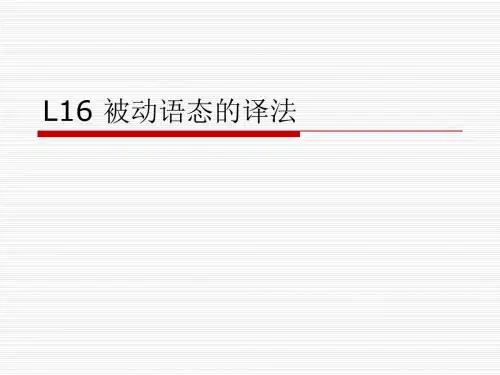
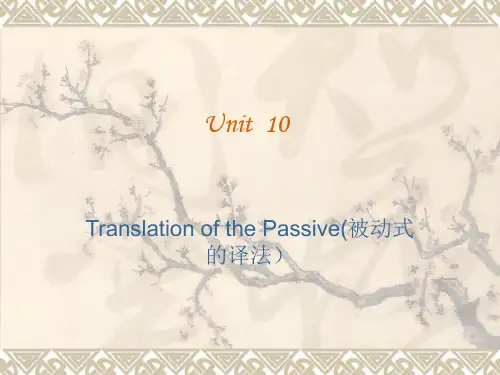
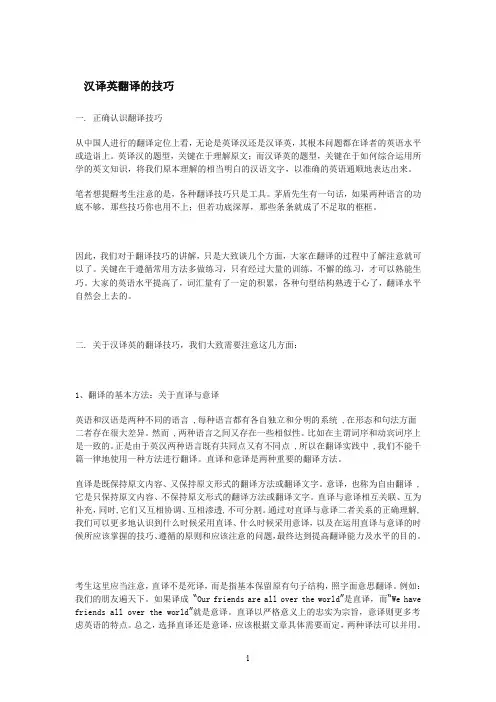
汉译英翻译的技巧一. 正确认识翻译技巧从中国人进行的翻译定位上看,无论是英译汉还是汉译英,其根本问题都在译者的英语水平或造诣上。
英译汉的题型,关键在于理解原文;而汉译英的题型,关键在于如何综合运用所学的英文知识,将我们原本理解的相当明白的汉语文字,以准确的英语通顺地表达出来。
笔者想提醒考生注意的是,各种翻译技巧只是工具。
茅盾先生有一句话,如果两种语言的功底不够,那些技巧你也用不上;但若功底深厚,那些条条就成了不足取的框框。
因此,我们对于翻译技巧的讲解,只是大致谈几个方面,大家在翻译的过程中了解注意就可以了。
关键在于遵循常用方法多做练习,只有经过大量的训练,不懈的练习,才可以熟能生巧。
大家的英语水平提高了,词汇量有了一定的积累,各种句型结构熟透于心了,翻译水平自然会上去的。
二. 关于汉译英的翻译技巧,我们大致需要注意这几方面:1、翻译的基本方法:关于直译与意译英语和汉语是两种不同的语言 ,每种语言都有各自独立和分明的系统 ,在形态和句法方面二者存在很大差异。
然而 ,两种语言之间又存在一些相似性。
比如在主谓词序和动宾词序上是一致的。
正是由于英汉两种语言既有共同点又有不同点 ,所以在翻译实践中 ,我们不能千篇一律地使用一种方法进行翻译。
直译和意译是两种重要的翻译方法。
直译是既保持原文内容、又保持原文形式的翻译方法或翻译文字。
意译,也称为自由翻译 ,它是只保持原文内容、不保持原文形式的翻译方法或翻译文字。
直译与意译相互关联、互为补充,同时,它们又互相协调、互相渗透,不可分割。
通过对直译与意译二者关系的正确理解,我们可以更多地认识到什么时候采用直译、什么时候采用意译,以及在运用直译与意译的时候所应该掌握的技巧、遵循的原则和应该注意的问题,最终达到提高翻译能力及水平的目的。
考生这里应当注意,直译不是死译,而是指基本保留原有句子结构,照字面意思翻译。
例如:我们的朋友遍天下。
如果译成“Our friends are all over the world”是直译,而“We have friends all over the world”就是意译。
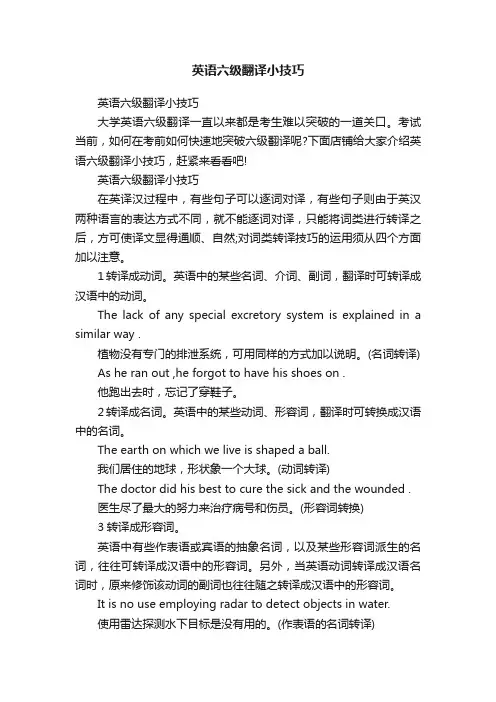
英语六级翻译小技巧英语六级翻译小技巧大学英语六级翻译一直以来都是考生难以突破的一道关口。
考试当前,如何在考前如何快速地突破六级翻译呢?下面店铺给大家介绍英语六级翻译小技巧,赶紧来看看吧!英语六级翻译小技巧在英译汉过程中,有些句子可以逐词对译,有些句子则由于英汉两种语言的表达方式不同,就不能逐词对译,只能将词类进行转译之后,方可使译文显得通顺、自然;对词类转译技巧的运用须从四个方面加以注意。
1转译成动词。
英语中的某些名词、介词、副词,翻译时可转译成汉语中的动词。
The lack of any special excretory system is explained in a similar way .植物没有专门的排泄系统,可用同样的方式加以说明。
(名词转译) As he ran out ,he forgot to have his shoes on .他跑出去时,忘记了穿鞋子。
2转译成名词。
英语中的某些动词、形容词,翻译时可转换成汉语中的名词。
The earth on which we live is shaped a ball.我们居住的地球,形状象一个大球。
(动词转译)The doctor did his best to cure the sick and the wounded .医生尽了最大的努力来治疗病号和伤员。
(形容词转换)3转译成形容词。
英语中有些作表语或宾语的抽象名词,以及某些形容词派生的名词,往往可转译成汉语中的形容词。
另外,当英语动词转译成汉语名词时,原来修饰该动词的副词也往往随之转译成汉语中的形容词。
It is no use employing radar to detect objects in water.使用雷达探测水下目标是没有用的。
(作表语的名词转译)The sun affects tremendously both the mind and body of a man .太阳对人的身体和精神都有极大的影响。
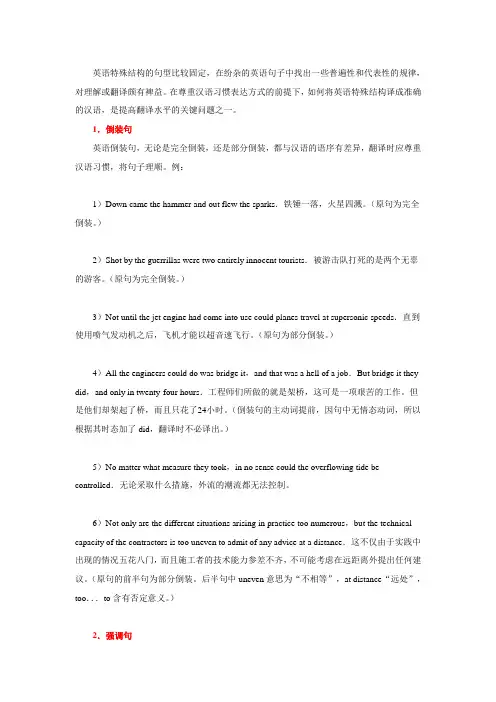
英语特殊结构的句型比较固定,在纷杂的英语句子中找出一些普遍性和代表性的规律,对理解或翻译颇有裨益。
在尊重汉语习惯表达方式的前提下,如何将英语特殊结构译成准确的汉语,是提高翻译水平的关键问题之一。
1.倒装句英语倒装句,无论是完全倒装,还是部分倒装,都与汉语的语序有差异,翻译时应尊重汉语习惯,将句子理顺。
例:1)Down came the hammer and out flew the sparks.铁锤一落,火星四溅。
(原句为完全倒装。
)2)Shot by the guerrillas were two entirely innocent tourists.被游击队打死的是两个无辜的游客。
(原句为完全倒装。
)3)Not until the jet engine had come into use could planes travel at supersonic speeds.直到使用喷气发动机之后,飞机才能以超音速飞行。
(原句为部分倒装。
)4)All the engineers could do was bridge it,and that was a hell of a job.But bridge it they did,and only in twenty-four hours.工程师们所做的就是架桥,这可是一项艰苦的工作。
但是他们却架起了桥,而且只花了24小时。
(倒装句的主动词提前,因句中无情态动词,所以根据其时态加了did,翻译时不必译出。
)5)No matter what measure they took,in no sense could the overflowing tide be controlled.无论采取什么措施,外流的潮流都无法控制。
6)Not only are the different situations arising in practice too numerous,but the technical capacity of the contractors is too uneven to admit of any advice at a distance.这不仅由于实践中出现的情况五花八门,而且施工者的技术能力参差不齐,不可能考虑在远距离外提出任何建议。
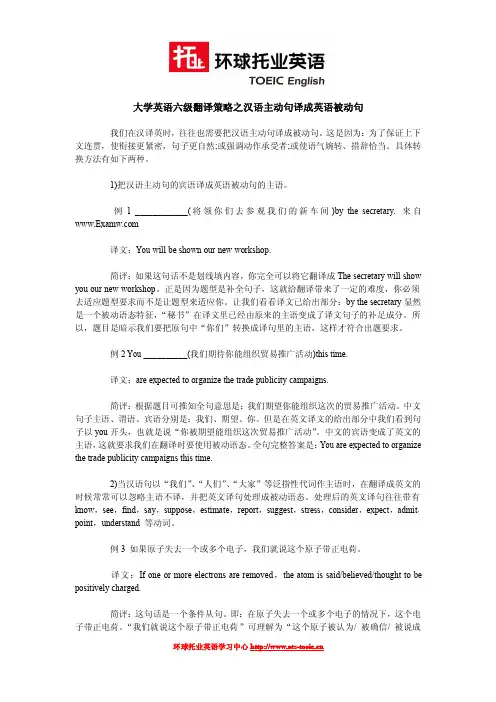
大学英语六级翻译策略之汉语主动句译成英语被动句我们在汉译英时,往往也需要把汉语主动句译成被动句。
这是因为:为了保证上下文连贯,使衔接更紧密,句子更自然;或强调动作承受者;或使语气婉转、措辞恰当。
具体转换方法有如下两种。
1)把汉语主动句的宾语译成英语被动句的主语。
例1____________(将领你们去参观我们的新车间)by the secretary.来自译文:You will be shown our new workshop.简评:如果这句话不是划线填内容,你完全可以将它翻译成The secretary will show you our new workshop。
正是因为题型是补全句子,这就给翻译带来了一定的难度,你必须去适应题型要求而不是让题型来适应你。
让我们看看译文已给出部分:by the secretary显然是一个被动语态特征,“秘书”在译文里已经由原来的主语变成了译文句子的补足成分。
所以,题目是暗示我们要把原句中“你们”转换成译句里的主语,这样才符合出题要求。
例2You__________(我们期待你能组织贸易推广活动)this time.译文:are expected to organize the trade publicity campaigns.简评:根据题目可推知全句意思是:我们期望你能组织这次的贸易推广活动。
中文句子主语、谓语、宾语分别是:我们、期望、你。
但是在英文译文的给出部分中我们看到句子以you开头,也就是说“你被期望能组织这次贸易推广活动”。
中文的宾语变成了英文的主语,这就要求我们在翻译时要使用被动语态。
全句完整答案是:You are expected to organize the trade publicity campaigns this time.2)当汉语句以“我们”、“人们”、“大家”等泛指性代词作主语时,在翻译成英文的时候常常可以忽略主语不译,并把英文译句处理成被动语态。
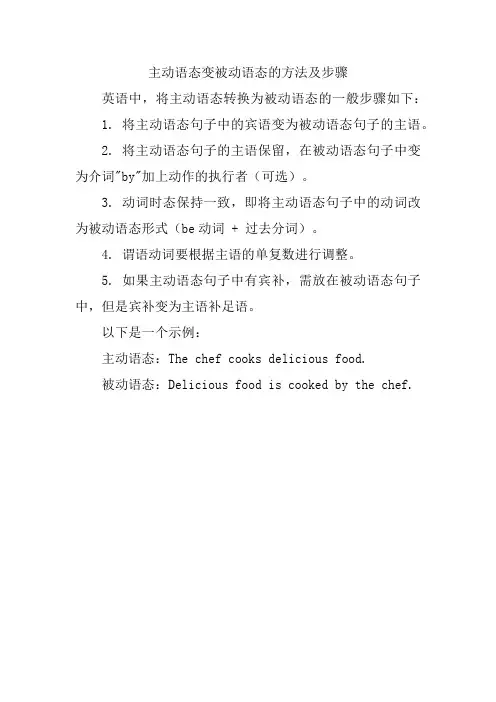
主动语态变被动语态的方法及步骤
英语中,将主动语态转换为被动语态的一般步骤如下:
1. 将主动语态句子中的宾语变为被动语态句子的主语。
2. 将主动语态句子的主语保留,在被动语态句子中变为介词"by"加上动作的执行者(可选)。
3. 动词时态保持一致,即将主动语态句子中的动词改为被动语态形式(be动词 + 过去分词)。
4. 谓语动词要根据主语的单复数进行调整。
5. 如果主动语态句子中有宾补,需放在被动语态句子中,但是宾补变为主语补足语。
以下是一个示例:
主动语态:The chef cooks delicious food.
被动语态:Delicious food is cooked by the chef.。
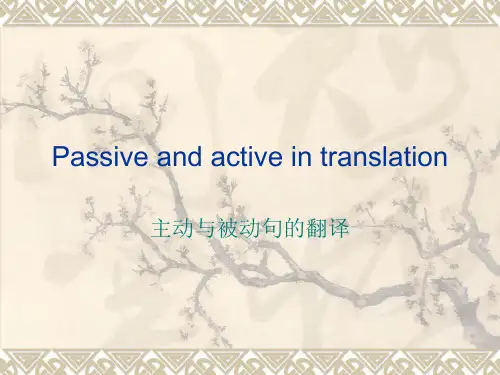
[翻译技巧] 名师总结2011四六级考试翻译主要考点四级翻译部分为汉译英,共5个句子,一句一题,句长为15-30词,句中的一部分已用英文给出,考生需根据全句意思将汉语部分译成英语,考试时间5分钟。
翻译题重点考察考生对语法结构及常用英语表达习惯的掌握情况。
若考生语法功底较好且句型和词组储备丰富,那么此题不会太为难。
和作文相比,翻译虽只是个把句子,但来路不明难以猜测。
作文尚可背诵模板以备执笔急需之用,而翻译则全无,它微小零星却锋利难防,并将考生模板式作文的画皮扯下,暴露其撰句能力的真实面目,所以令人可畏。
根据近几年的翻译真题来看,针对某项语法重复考察率比较高,所以对曾经考察过的语法点依然不可松懈。
下面所提一些重点语法工程,并提出一些建议,希望对大家的备考有所帮助。
(1)句型以及其倒装使用2008年6月翻译真题第91题:__________________________(直到他完成使命)did he realize that he was seriously ill. (Key:Not until he accomplished / finished the mission )建议:以此类推,掌握如下常用句型(以倒装方式给出)Not only ……..but also……So ( Such )…that……..Not until……….Neither…..nor……..Hardly …..when……..No sooner ……than…….Only by /through /in …., …………..例:Not only __________ (他向我收费过高)but he didn’t do a good repair. (key:did he charge me too much)(2)从句a. 定语从句2008年12月翻译真题第87题:Medical researchers are painfully aware that there are many problems _________________(他们至今还没有答案) (Key :which/that they haven’t found answers to)b. 状语从句真题中出现过如if 条件状语从句(2007 年6月第91题),no matter引导的让步状语从句(2007年12月第89题和2008年6月第89题)建议:关于定语从句,到目前为止所考察的均为关系代词which/ that等所引导的,所以考生需额外留意关系副词where/ when/how 所引导的定语从句。
翻译技巧6 被动句的翻译1. 译成主动句Mr. White was given a prize.This problem will be discussed at the next meeting.Safe and reliable, this medicineis extensively used in medical treatment.All items for which we have quotedare made from very best silk.All our prices are quoted CIF to the port of destination.The units orderedwere delivered to you on May 16and payment to due on June 20.Please note each cargo shouldbe wrapped up in oil-paper andpacked in a zinc-lined case.2. 被动句的主语在译文中作宾语Mr. Lee is considered to be a very responsible director. Large quantities of fuel are used by modern industry.The articles have just been receivedafter a delay of fortnight,for which no explanation has yet been given to us.As the date of delivery is approaching,you are requested to expedite the establishment of the L/C.We are following this situation closelyand you will be quickly informed as to any change.The markets are influencedby the situation of the stocksbut improvements are expected.If the following goods can be supplied,please accept this as our order for 200 sets of your goods.Since many orders from our regular customersare rushing in, prompt shipment cannot be guaranteed after the end of March.由于接到了很多来自我们长期客户的订单,故此,在3月底后,我们将难以保证即期交货。
本文部分内容来自网络整理,本司不为其真实性负责,如有异议或侵权请及时联系,本司将立即删除!== 本文为word格式,下载后可方便编辑和修改! ==汉语主动句译成英语被动句方法汉语主动句译成英语被动句我们在汉译英时,往往也需要把汉语主动句译成被动句。
这是因为:为了保证上下文连贯,使衔接更紧密,句子更自然;或强调动作承受者;或使语气婉转、措辞恰当。
具体转换方法有如下两种。
1)把汉语主动句的宾语译成英语被动句的主语。
例1 ____________(将领你们去参观我们的新车间)by the secretary. 来自译文:You will be shown our new workshop.简评:如果这句话不是划线填内容,你完全可以将它翻译成The secretary will show you our new workshop。
正是因为题型是补全句子,这就给翻译带来了一定的难度,你必须去适应题型要求而不是让题型来适应你。
让我们看看译文已给出部分:by the secretary显然是一个被动语态特征,“秘书”在译文里已经由原来的主语变成了译文句子的补足成分。
所以,题目是暗示我们要把原句中“你们”转换成译句里的主语,这样才符合出题要求。
例2 You __________(我们期待你能组织贸易推广活动)this time.译文:are expected to organize the trade publicity campaigns.简评:根据题目可推知全句意思是:我们期望你能组织这次的贸易推广活动。
中文句子主语、谓语、宾语分别是:我们、期望、你。
但是在英文译文的给出部分中我们看到句子以you开头,也就是说“你被期望能组织这次贸易推广活动”。
中文的宾语变成了英文的主语,这就要求我们在翻译时要使用被动语态。
全句完整答案是:You are expected to organize the trade publicity campaigns this time.2)当汉语句以“我们”、“人们”、“大家”等泛指性代词作主语时,在翻译成英文的时候常常可以忽略主语不译,并把英文译句处理成被动语态。
被动语态的译法一、译成汉语主动句(一)、原文中的主语在译文中仍作主语The whole country was armed in a few days.几天之内全国就武装起来了。
The sense of inferiority that he acquired in his youth has never been totally eradicated.他在青少年时期留下的自卑感,还没有完全消除。
On their domestic stations events in the Middle East were dismissed briefly.在他们国内电台的广播中,中东事件只是轻描淡写地报道了一下。
练习:This liquid became mixed with the salt at room temperature.这液体在室温下和盐混合了。
It should have been obvious that the plan would have to be scrapped.本来就很明显,这项计划得取消。
Most of the questions have been settled satisfactory, only a few questions of secondary importance remain to be discussed.大部分问题已经圆满地解决了,只剩下几个次要问题需要讨论。
(二)、原文中的主语在译文中作宾语Mr. Billings cannot be deterred from his plan.(人们)不能阻止比林斯先生实行他的计划。
It would be astonishing if that loss were not keenly felt.如果(人们)不强烈地感到损失,那倒是奇怪了。
By the end of the war, 800 people had been saved by the organization, but at a cost of over 200 Belgian and French lives.大战终了时,这个组织拯救了800人,但那是以200多比利时人和法国人的生命为代价的。
最牛英语口语培训模式:躺在家里练口语,全程外教一对一,三个月畅谈无阻!洛基英语,免费体验全部在线一对一课程:/ielts/xd.html(报名网址)英语中被动语态的使用范围极为广泛, 尤其是在科技英语中, 被动语态几乎随处可见, 凡是在不必、不愿说出或不知道主动者的情况下均可使用被动语态, 因此, 掌握被动语态的翻译方法, 对于硕士研究生入学考试的复习与应考是极为重要的, 因为在硕士研究生入学考试中,英译汉文章的内容多以科普文章为主。
在汉语中, 也有被动语态, 通常通过“把”或“被”等词体现出来, 但它的使用范围远远小于英语中被动语态的使用范围, 因此英语中的被动语态在很多情况下都翻译成主动结构。
对于英语原文的被动结构, 我们一般采取下列的方法:1. 翻译成汉语的主动句。
英语原文的被动结构翻译成汉语的主动结构又可以进一步分为几种不同的情况。
(1) 英语原文中的主语在译文中仍做主语。
在采用此方法时, 我们往往在译文中使用了“加以”,“经过”, “用……来”等词来体现原文中的被动含义。
例如: 例1.Other questions will be discussed briefly.其他问题将简单地加以讨论。
例2.In other words mineral substances which are found on earth must be extracted by digging, boring holes, artificial explosions, or similar operations which make them available to us.换言之, 矿物就是存在于地球上, 但须经过挖掘、钻孔、人工爆破或类似作业才能获得的物质。
例3.Nuclear power's danger to health, safety, and even life itself can be summed up in one word: radiation.核能对健康、安全, 甚至对生命本身构成的危险可以用一个词—辐射来概括。
大学英语六级翻译策略之汉语主动句译成英语被动句
我们在汉译英时,往往也需要把汉语主动句译成被动句。
这是因为:为了保证上下文连贯,使衔接更紧密,句子更自然;或强调动作承受者;或使语气婉转、措辞恰当。
具体转换方法有如下两种。
1)把汉语主动句的宾语译成英语被动句的主语。
例1____________(将领你们去参观我们的新车间)by the secretary.来自
译文:You will be shown our new workshop.
简评:如果这句话不是划线填内容,你完全可以将它翻译成The secretary will show you our new workshop。
正是因为题型是补全句子,这就给翻译带来了一定的难度,你必须去适应题型要求而不是让题型来适应你。
让我们看看译文已给出部分:by the secretary显然是一个被动语态特征,“秘书”在译文里已经由原来的主语变成了译文句子的补足成分。
所以,题目是暗示我们要把原句中“你们”转换成译句里的主语,这样才符合出题要求。
例2You__________(我们期待你能组织贸易推广活动)this time.
译文:are expected to organize the trade publicity campaigns.
简评:根据题目可推知全句意思是:我们期望你能组织这次的贸易推广活动。
中文句子主语、谓语、宾语分别是:我们、期望、你。
但是在英文译文的给出部分中我们看到句子以you开头,也就是说“你被期望能组织这次贸易推广活动”。
中文的宾语变成了英文的主语,这就要求我们在翻译时要使用被动语态。
全句完整答案是:You are expected to organize the trade publicity campaigns this time.
2)当汉语句以“我们”、“人们”、“大家”等泛指性代词作主语时,在翻译成英文的时候常常可以忽略主语不译,并把英文译句处理成被动语态。
处理后的英文译句往往带有know,see,find,say,suppose,estimate,report,suggest,stress,consider,expect,admit,point,understand等动词。
例3如果原子失去一个或多个电子,我们就说这个原子带正电荷。
译文:If one or more electrons are removed,the atom is said/believed/thought to be positively charged.
简评:这句话是一个条件从句。
即:在原子失去一个或多个电子的情况下,这个电子带正电荷。
“我们就说这个原子带正电荷”可理解为“这个原子被认为/被确信/被说成
是带正电荷”。
那么根据前面所说的原则,我们在翻译时可以将泛指性主语“我们”省略不译,并使用被动语态。
从这个例子里我们还可以看出,在科技文章中,根据英语表达习惯我们应当多采用被动语态,以强调事物的客观性。
例4人们采用各种措施来防止腐蚀。
译文:All kinds of measures are taken to prevent corrosion.
简评:这句话可以按原文译成主动态,即:People have taken all kinds of measures to prevent corrosion。
也可以用被动语态来翻译——All kinds of measures are taken to prevent corrosion。
两者比较而言,被动态译文更突出表明所有、种种措施已经付诸实施,all kinds of measures得到强调,而主动态译法只是平铺直叙,重点不突出。
此外,汉语句子中有“据说”、“据了解”、“据报道”、“据估计”、“据传言”等词语时,可以酌情译成相应的英语被动句,如:It is supposed that(据推测……),It is said that(据说……),It is estimated that(据估计……),It is calculated that(预计……),It is reported that(据报道……),It is suggested that(有人建议),It is stressed that(有人强调……),It is thought that(有人认为……),It is considered that(有人认为……),It is expected that(据期望……),It is well known that(众所周知……),It must be admitted that(必须承认……),It must be pointed out that(必须指出……),It is understood that(谁都知道……),It may be safety said that(可以有把握地说……)等。
例5据了解,这个地区有丰富的自然资源。
译文:The area is known to be rich in natural resources.
例6众所周知,自然光其实是由许多种颜色构成。
译文:It is well known that natural light is actually made up of many colors.
下期介绍汉语无主句译成英语被动句。
Exercise Eleven
1.A dog has won a German government award________________(因协助警方劝阻一名妇女自杀).
2.The manager points out_______________(我们的工作进展令人满意).
3._________________(这栋房子需要现代化):it has no bathroom or electricity.
4.________________(飞机什么时候起飞)has not been announced.
5.His idea is________________(应该立即执行计划).
答案:
1.for helping police persuade a woman not to commit suicide
解析:本句考查的是句子逻辑关系。
根据意思可知,句子前半句是果,后半句是因。
“一只狗因为协助警方阻止了一名妇女的自杀而获德国政府奖项”。
英语通常把表示目的、假设、原因、让步等内容放在句子的后部,因此这句话可以由because,for来引导。
“自杀”有一个固定短语commit suicide,“劝阻”要用强调结果成功的persuade。
2.that our work is progressing satisfactorily
解析:本题考查词性的转译,即:将原汉语句子中的动词“令人满意”转移成英语的副词satisfactorily。
这种词性转换是翻译常用技巧,适当的转换可使译文通顺,符合英文表达习惯。
另外,句子需填入部分在全句中充当宾语从句,因而不能漏译that。
3.This house needs modernizing
解析:本题同样考查汉英词性转换技巧。
全句意为:这栋房子既没有浴室也没有电,(因而)需要现代化。
“现代化”在汉语里是一个名词,在这个句子中实际上指的是“房子”需要配置现代化设备,它的含义不等同于modernization,“配备现代化设施”可以用modernizing来表示。
英语里很多以-ing结尾的动词表示该动作的过程,通常与need连用,如:These clothes need washing.本题是从名词到动词的转换。
4.When the plane is to take off
解析:本题考查的是以连接副词when引导的主语从句的翻译。
中文意思是:飞机什么时候起飞还没有公布。
这样的主语从句一般可以采用顺序法翻译。
顺序法同样也适用于以that,what,whatever,who,whoever,where,how,why等引导的主语从句。
如:认识他的人都信任他。
(Who knows him will believe him.)本题的另一个考点是:“什么时候起飞”是一个将来时态,可以用be to来表达。
5.that the plan should be carried out immediately
解析:本题综合考查了表语从句、无主语翻译以及惯用搭配。
首先,His idea is前半部分是一个完整的主谓结构,句子需填入部分在全句中充当表语;其次,“应该立即执行计
划”中“计划”是被用来执行的,但是题干中并没有提到谁会来执行这个计划。
因此,在主语没有出现的情况下,可以采用被动译法。
“执行计划”在英语里可以用carry out the plan,perform the plan,implement the plan来表示。
上述内容由环球托业英语学习中心收集整理,更多精彩的英语学习内容尽在环球托业英
语的官方网站。